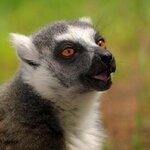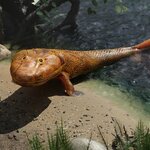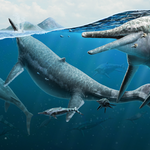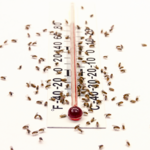Evolution

If you have been to a zoo and been around our primate evolutionary cousins with kids, you may have had an awkward moment or two. They are going to masturbate, and don't care who's watching.
A new study says more is better. The Postcopulatory Selection Hypothesis believes it helps shed low-quality semen while the The Pathogen Avoidance Hypothesis believes it may reduce the risk of contracting sexually-transmitted infections. Primates have been doing it for at least 40 million years so something keeps it going.
The authors used a Monte Carlo analysis on survey data of 150 expert witnesses and…

A phrase like 'spring in your step' is usually meant to evoke enthusiasm or happiness but a new study finds that its mechanism, the spring-like arch in our feet, did help us walk on two feet. Just in a different way than previously believed.
Most believe that the raised arch of the foot helps us walk by acting as a lever which helps to lift the body into the next step by propelling the body forward but the new work argues that the recoil of the flexible arch repositions the ankle upright for more effective walking - and the effects in running are even greater.
While a flexible arch and its…

When you think about human evolution, there’s a good chance you’re imagining chimpanzees exploring ancient forests or early humans daubing woolly mammoths on to cave walls. But we humans, along with bears, lizards, hummingbirds and Tyrannosaurus rex, are actually lobe-finned fish.
It might sound bizarre but the evidence is in our genes, anatomy and in fossils. We belong to a group of animals called land-dwelling sarcopterygians, but vast amounts of evolutionary change have obscured our appearance.
3D rendering of the tiktaalik, an extinct walking fish. Dotted Yeti/Shutterstock
We think…

An analysis of the 1.5 million-year-old cranium DAN5/P1, found at the Gona site in Ethiopia, has cranial cranial morphology which indicates that it belongs to the species Homo erectus but near the earliest African stage, where it is sometimes identified using the name H. ergaster.
The fossil is very small for these hominin groups and suggest that its cerebral morphology does not present any traits distinctive to the human genus: its proportions are similar to those of australopiths or species whose evolutionary position, and whether they are from our own lineage, remains to be determined, as…

We have a body clock that changes with exposure to sun and a new study finds that while humans don't hibernate, we do sleep longer in the winter.
Researchers recruited 292 patients that had undergone sleep studies called polysomnographies at the St Hedwig Hospital. These studies are regularly carried out on patients who experience sleep-related difficulties, using a special laboratory where patients are asked to sleep naturally without an alarm clock, and the quality and type of sleep can be monitored as well as the length of sleep. Although the sleep disorders could potentially…

Giant blue and humpback whales migrate across the ocean to breed and give birth in waters where predators are scarce.
A new analysis of the fossil bed in the Berlin-Ichthyosaur State Park (BISP) in Nevada’s Humboldt-Toiyabe National Forest suggests that nearly 200 million years before giant whales evolved, school bus-sized marine reptiles called ichthyosaurs may have been making similar migrations to breed and give birth together in relative safety.
Nevada is east of the very large state of California, and the study offers a possible explanation why at least 37 of these marine reptiles…

Although neanderthals died out over 40,000 years ago, we are living in an age in which there are more people with their DNA than at any other time in history, with research finding that all modern human beings have neanderthal DNA in them. Homo neanderthalensis evolved some 400,000 years ago, and in their time on earth, they interbred with our ancestors in waves out of and into Africa. Recent evidence shows that this process of hybridizing between ancient humans and neanderthals and other groups was a constant feature of ancient life.
The Old Scientific Consensus
As professors…

If you get sleepy in the middle of hot days, you are not alone. You are not even alone in the animal kingdom.
Biology may be behind it.
We know that many people have a harder time sleeping in the summer and be slow to get out of bed on colder mornings and new study hopes to connect sensory neurons and neurons that control this cycle.
The work is only in fruit flies, so it goes in the exploratory pile despite the hyper-coverage such studies get in corporate media, but they found that fruit flies are pre-programmed to take a nap in the middle of the day. They believe there is a brain…

An experiment found that selfing” monkeyflower plants lost 13 percent to 24 percent of their genetic variation compared to another group that were propagated by bumble bees.
Genetic variation is important to respond to changes in nature or the overall environment. The good news is that they used bumblebees and though they claim they are in decline, evidence does not show that, so the plants are not at short term risk. Even better, pollination is not done by bumblebees alone, there are over 25,000 species of just bees, and lots of other insects pollinate. An experiment outside a closed…

Our planet’s origins and its ancient history has fascinated human beings since the dawn of civilization. According to Science Alert, over 35 million years ago, the ancestor of modern cetaceans, i.e. fully aquatic mammals such as whales, dolphins and porpoises, returned to the sea, aided by its unique eyesight that allowed it to see in the deep.
Return to the Sea
It may surprise many people that cetaceans evolved from ancestors that lived on the land. This is clear from many of their features. Cetaceans breathe air, they nurse their young with milk, and their flippers encase bones that mark…